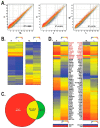The Tissue-Engineered Human Psoriatic Skin Substitute: A Valuable In Vitro Model to Identify Genes with Altered Expression in Lesional Psoriasis
- PMID: 30261611
- PMCID: PMC6213003
- DOI: 10.3390/ijms19102923
The Tissue-Engineered Human Psoriatic Skin Substitute: A Valuable In Vitro Model to Identify Genes with Altered Expression in Lesional Psoriasis
Abstract
Psoriasis is a chronic inflammatory skin disease for which no cure has emerged. Its complex etiology requires the development of an in vitro model representative of the pathology. In this study, we exploited gene profiling analyses on microarray in order to characterize and further optimize the production of a human psoriatic skin model representative of this in vivo skin disease. Various skin substitutes were produced by tissue-engineering using biopsies from normal, healthy donors, or from lesional or non-lesional skin samples from patients with psoriasis, and their gene expression profiles were examined by DNA microarray. We demonstrated that more than 3540 and 1088 genes (two-fold change) were deregulated between healthy/lesional and lesional/non-lesional psoriatic substitutes, respectively. Moreover, several genes related to lipid metabolism, such as PLA2G4E and PLA2G4C, were identified as repressed in the lesional substitutes. In conclusion, gene profiling analyses identified a list of deregulated candidate genes associated with various metabolic pathways that may contribute to the progression of psoriasis.
Keywords: gene profiling; psoriasis; tissue-engineering.
Conflict of interest statement
The authors declare no conflict of interest.
Figures



Similar articles
-
Tissue-engineered human psoriatic skin supplemented with cytokines as an in vitro model to study plaque psoriasis.Regen Med. 2016 Sep;11(6):545-57. doi: 10.2217/rme-2016-0037. Epub 2016 Aug 11. Regen Med. 2016. PMID: 27513102
-
Antiviral gene expression in psoriasis.J Eur Acad Dermatol Venereol. 2015 Oct;29(10):1951-7. doi: 10.1111/jdv.13091. Epub 2015 Mar 23. J Eur Acad Dermatol Venereol. 2015. PMID: 25809693 Free PMC article.
-
Comparisons of gene expression in normal, lesional, and non-lesional psoriatic skin using DNA microarray techniques.Int J Dermatol. 2014 Oct;53(10):1213-20. doi: 10.1111/ijd.12476. Epub 2014 Jul 11. Int J Dermatol. 2014. PMID: 25041445
-
MicroRNA profiling of psoriatic skin identifies 11 miRNAs associated with disease severity.Exp Dermatol. 2022 Apr;31(4):535-547. doi: 10.1111/exd.14497. Epub 2021 Nov 17. Exp Dermatol. 2022. PMID: 34748247 Review.
-
Screening of Skin Lesion-Associated Genes in Patients with Psoriasis by Meta-Integration Analysis.Dermatology. 2017;233(4):277-288. doi: 10.1159/000481619. Epub 2017 Nov 15. Dermatology. 2017. PMID: 29136636 Review.
Cited by
-
Keratinocyte-to-macrophage communication exacerbate psoriasiform dermatitis via LRG1-enriched extracellular vesicles.Theranostics. 2024 Jan 1;14(3):1049-1064. doi: 10.7150/thno.89180. eCollection 2024. Theranostics. 2024. PMID: 38250043 Free PMC article.
-
Docosahexaenoic Acid Modulates Paracellular Absorption of Testosterone and Claudin-1 Expression in a Tissue-Engineered Skin Model.Int J Mol Sci. 2021 Dec 3;22(23):13091. doi: 10.3390/ijms222313091. Int J Mol Sci. 2021. PMID: 34884896 Free PMC article.
-
Review-Current Concepts in Inflammatory Skin Diseases Evolved by Transcriptome Analysis: In-Depth Analysis of Atopic Dermatitis and Psoriasis.Int J Mol Sci. 2020 Jan 21;21(3):699. doi: 10.3390/ijms21030699. Int J Mol Sci. 2020. PMID: 31973112 Free PMC article. Review.
-
Identification of copper death-associated molecular clusters and immunological profiles for lumbar disc herniation based on the machine learning.Sci Rep. 2024 Aug 20;14(1):19294. doi: 10.1038/s41598-024-69700-0. Sci Rep. 2024. PMID: 39164344 Free PMC article.
-
Bioengineered Skin Intended as In Vitro Model for Pharmacosmetics, Skin Disease Study and Environmental Skin Impact Analysis.Biomedicines. 2020 Oct 31;8(11):464. doi: 10.3390/biomedicines8110464. Biomedicines. 2020. PMID: 33142704 Free PMC article. Review.
References
MeSH terms
Substances
Grants and funding
LinkOut - more resources
Full Text Sources
Other Literature Sources
Medical

